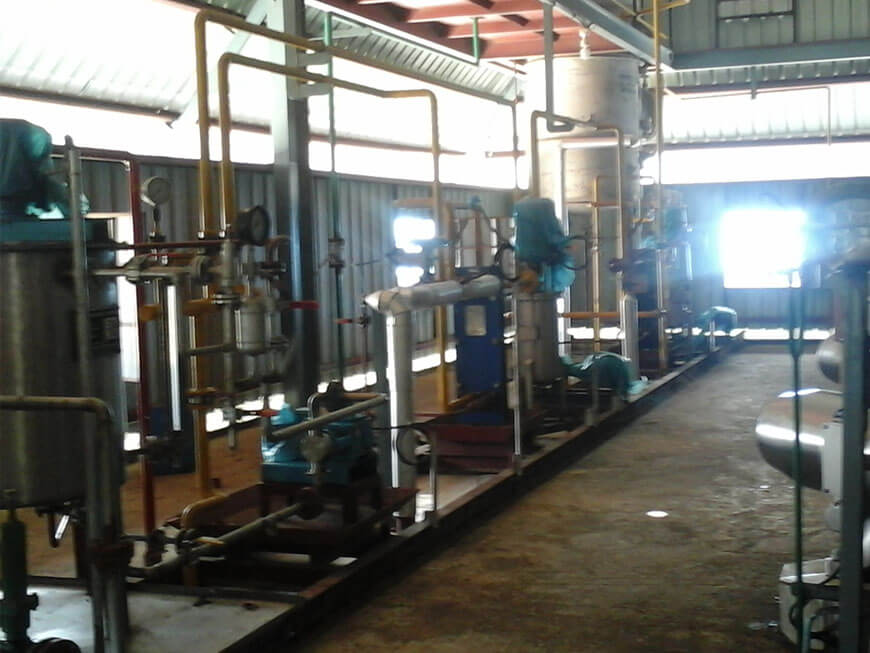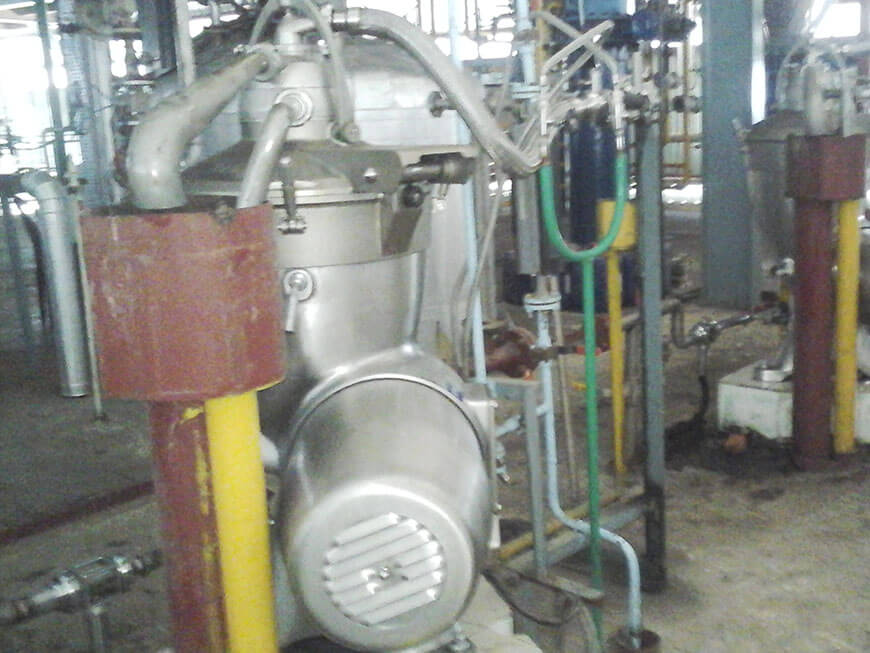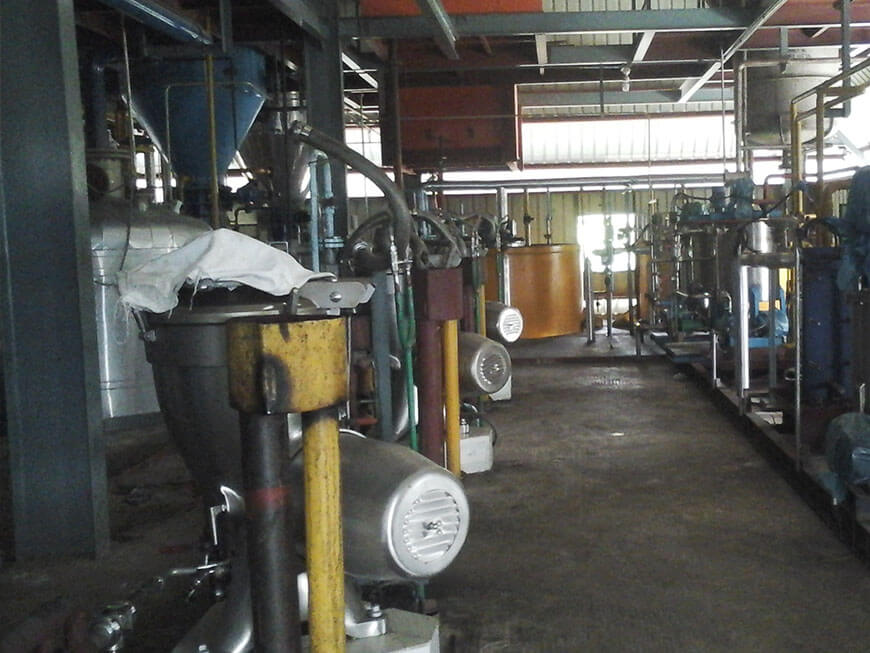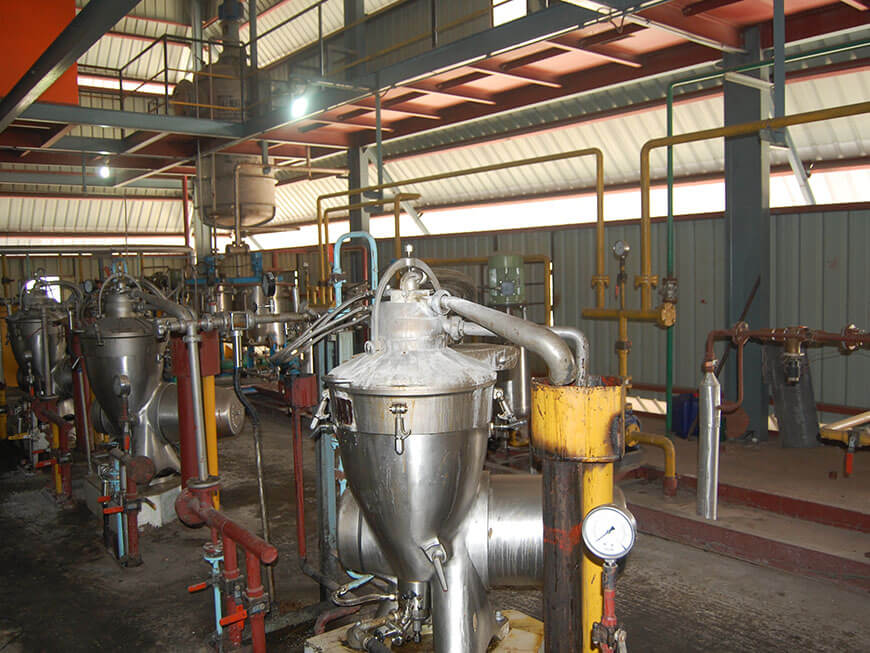Edible Oil Refining Water Degumming / Enzymatic Degumming / Acid Gum Conditioning
Water Degumming / Enzymatic Degumming / Acid Gum Conditioning
Water Degumming
What is Water Degumming
Water degumming is a process employed in the oil refining industry, specifically in the refining of vegetable oils, to remove impurities known as gums from the oil. Gums are phospholipids that are naturally present in crude oils extracted from seed like soybeans, sunflowers, rice bran, corn and rapeseeds. These impurities can have negative effects on the quality and stability of the oil.
The water degumming process involves the addition of water to the crude oil, causing the gums to hydrate and separate from the oil. The mixture is then allowed to separate and the water with the hydrated gums is removed from the oil. This separation is typically facilitated by centrifugation or gravity settling.
The use of water quality and conditions in the degumming process is crucial, as it has to allow gums to precipitate without forming the emulsions with oil. The water degumming step is often followed by further refining processes, such as gum conditioning, neutralization and bleaching, to achieve the desired quality of the refined oil.
Water Degumming Process Of Oil
The water degumming process can be outlined in several steps:
Addition of Water
- The first step involves adding water with appropriate temperature to the crude oil. This addition facilitates the hydration of gums, causing them to absorb water and swell.
Hydration of Gums
- As water is introduced, the gums in the crude oil undergo hydration for appropriate time intervals. This process is crucial for breaking the emulsion, allowing the gums to separate from the oil.
Separation
- The next step involves separating the water, which now contains the hydrated gums, from the oil. Techniques such as centrifugation or gravity settling are commonly employed for this purpose.
Removal of Water and Gums
- The water, along with the hydrated gums, is then removed from the oil, leaving behind a degummed oil with reduced phospholipid impurities.
It's important to note that the effectiveness of the water degumming process can be influenced by factors such as temperature, mixing intensity, and the quality of the crude oil. Following water degumming, additional refining steps may be undertaken, such as gum conditioning, neutralization and bleaching, to further enhance the quality of the oil.
The water degumming process is a critical component of the overall degumming process of oil, employing water to induce the hydration and separation of gums from crude oils, ultimately leading to the production of refined oils with improved quality and stability.
Enzyme Addition
- The process begins with the addition of specific enzymes, often phospholipases, to the crude oil. These enzymes play a crucial role in targeting and breaking down phospholipids, a major component of gums present in the oil.
Hydrolysis of Phospholipids
- The added enzymes catalyze the hydrolysis of phospholipids, causing the breakdown of these molecules. This enzymatic action results in the cleavage of fatty acids and other components from the phospholipids.
Formation of Hydrated Gums
- The hydrolysis products lead to the formation of hydrated gums. These hydrated gums are water-soluble and can be easily separated from the oil.
Separation
- The mixture, now containing water and the water-soluble hydrated gums, undergoes a separation process. Common methods for separation include centrifugation or gravity settling, allowing the gums to be separated from the oil.
Removal of Water and Gums
- The final step involves removing the water, along with the hydrated gums, from the oil. This results in a degummed oil with reduced phospholipid content and improved overall quality.
Acid Addition
- The initial step involves adding a small amount of acid to the crude oil. This acid reacts with the gums, primarily composed of phospholipids, initiating the degumming process.
Gum Precipitation
- The acid interacts with the phospholipids, causing them to precipitate as solid particles. This solid material, often referred to as sludge or foots, contains the gums and other impurities present in the oil.
Settling
- The mixture undergoes a settling process, allowing the solid precipitates to separate from the oil. This separation can occur naturally or be facilitated by techniques such as centrifugation.
Solid Removal
- The separated solid precipitates, which contain the gums, are then removed from the oil, resulting in a degummed oil.
Optional Neutralization/ washing
- Depending on the specific requirements, an optional neutralization step may follow acid degumming to eliminate any residual acidity in the oil.
Enzymatic Degumming
Enzymatic Degumming
The ENZYMATIC DEGUMMING TECHNOLOGY is Research, Developed by IICT (Indian Institute Of Chemical Technology) HYDERABAD. A subsidiary of CSIR (Council of Scientific and Industrial Research) under TMOP and M (Technology Mission of Oilseed, Pulses and Maize) Ministry of Agriculture, Govt. Of India.
We have done the TOTAL ENGINEERING of the ENZYMATIC DEGUMMING TECHNOLOGY and successfully implemented and commissioned the plants on commercial scale. The TECHNOLOGY is available with us. The enzymatic degumming process has significantly checked the CONTENT of PHOSPHORUS level in every oil.
What is Enzymatic Degumming
Enzymatic degumming is a specialized technique used in the refining of oils, particularly in the production of vegetable oils. In this process, specific enzymes, often phospholipases, are employed to target and break down undesirable gum impurities present in crude oils. The enzymatic action results in the hydrolysis of phospholipids, leading to the formation of water-soluble fragments known as hydrated gums. These hydrated gums can then be separated from the oil, resulting in a degummed oil with reduced impurities. Enzymatic degumming is valued for its ability to selectively target specific components, offering a milder and more controlled approach compared to traditional degumming methods. This method is recognized for its capacity to preserve the nutritional quality of oils by minimizing the loss of bioactive components during the refining process.
Enzymatic Degumming Process
The enzymatic degumming process is a specialized technique employed in the refining of oils, particularly in the production of vegetable oils, and it involves a series of steps utilizing enzymes to remove undesirable gum impurities from crude oils.
Enzymatic degumming is favored for its ability to selectively target specific impurities, offering a milder and more controlled approach compared to traditional degumming methods. Additionally, this method is recognized for preserving the nutritional quality of oils by minimizing the loss of bioactive components during the refining process. The enzymatic degumming process contributes to the production of refined vegetable oils with enhanced quality and nutritional attributes.
Acid Degumming
What is Acid Degumming
Acid degumming is a refining process employed in the production of oils, particularly vegetable oils. This method involves the addition of food-grade acids, such as phosphoric acid or citric acid, to crude oil to facilitate the removal of impurities known as gums. These gums, primarily composed of phospholipids, are naturally present in crude oils from sources like soybeans and sunflowers. Through the acid degumming process, these impurities are precipitated and separated from the oil, resulting in a degummed oil with improved clarity and stability. While effective, acid degumming may lead to the loss of some minor components, and additional refining steps like neutralization and bleaching are often employed to further enhance the quality of the refined oil.
Acid Degumming Process
Acid degumming is effective in reducing the phospholipid content in crude oil, contributing to improved clarity and stability of the refined oil. However, it may lead to the loss of some minor components, and additional refining steps like neutralization and bleaching are often applied to further enhance the quality of the oil. Overall, the acid degumming process plays a key role in the production of refined vegetable oils with desirable characteristics.
Importance of Water, Acid & Enzymatic Degumming Process
Water degumming, acid degumming, and enzymatic degumming processes are each significant in the oil refining industry, and their importance lies in their unique contributions to the production of high-quality oils. Here's a breakdown of the importance of each degumming process:
Water Degumming
- Impurity Removal: Water degumming is effective in removing water-soluble impurities, primarily phospholipids, from crude oils. This contributes to the reduction of gums in the oil.
- Preservation of Nutrients: Compared to some other degumming methods, water degumming is relatively mild, preserving the nutritional qualities of the oil. It is especially important in applications where maintaining the original nutrient content of the oil is a priority.
- Initial Refining Step: Water degumming is often the first step in the refining process, setting the stage for subsequent refining steps such as neutralization and bleaching.
Acid Degumming
- Phospholipid Removal: Acid degumming is particularly effective in removing non hydratable phospholipids from crude oils. The addition of food-grade acids facilitates the precipitation of gums, leading to their separation from the oil.
- Enhanced Clarity and Stability: Acid degumming contributes to improved clarity and stability of the oil by eliminating impurities. The process is especially valuable in achieving these qualities in the final refined product.
- Versatility: Acid degumming is versatile and can be applied to various vegetable oils, providing flexibility in the refining process.
Enzymatic Degumming
- Selective Degumming: Enzymatic degumming is known for its selective action in breaking down specific components, particularly phospholipids. This selectivity allows for targeted removal of impurities.
- Milder Process: Enzymatic degumming is generally considered a milder process compared to some chemical methods, resulting in reduced loss of minor components and preserving the nutritional quality of the oil.
- Environmentally Friendly: The use of enzymes in the degumming process is considered environmentally friendly as it often involves biodegradable materials and requires lower energy input.
Each degumming process water, acid, and enzymatic has its unique advantages and applications. The choice of the degumming method depends on factors such as the desired quality of the final oil, the specific characteristics of the crude oil, and environmental considerations. The combined use of these methods in oil refining allows for the production of oils tailored to various industrial, culinary, and nutritional needs.




